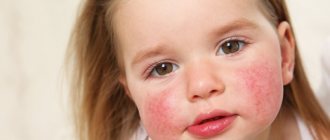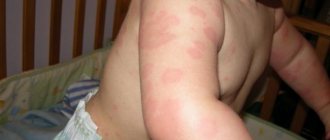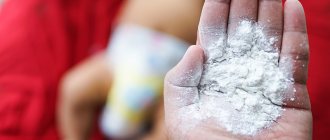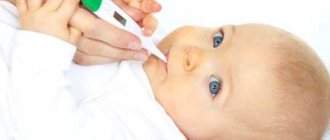General information
The name of the disease is due to the fact that outwardly it looks like a nettle burn - the skin turns pink and swells, while small blisters can merge into large local spots (angioedema) of irregular shape.
Papules cause itching and discomfort; when scratched, the wound surface can become infected, and then dermatitis and other complications join the underlying disease. The disease is very common; every third person on the planet has suffered from urticaria in one form or another.
Symptoms of urticaria in children
The main sign of urticaria in a child is a rash. Its prevalence and severity may vary, but in most cases the disease follows a single pattern.
- Convex pink and red rashes appear that turn pale when the skin is pressed or stretched. When the blisters merge, the edges of the spots become more intensely colored.
- The appearance of blisters, their disappearance or merging into vast shapeless foci occurs chaotically, and their migration over the surface of the body is unpredictable.
- The rash is accompanied by severe itching.
- The temperature may rise, either slightly or to high values.
- Often - weakness, malaise, joint pain and headache.
- In the complicated form, difficulty breathing or swallowing, nausea and vomiting, and bowel movements.
- An even more severe manifestation is angioedema on the lips, oral mucosa, eyelids, cheeks or genitals.
The localization of the appearance of the rash can be anywhere, including on the mucous membranes - lips, nasopharynx, ears and genitals. Most often, the upper part of the body and arms are affected, while the symmetry of the rashes is not always present; the spots take on the most bizarre coral-like shapes.
In most cases, allergies in the form of urticaria in children are accompanied only by the appearance of an itchy rash, which does not last long, from several hours to several days. Often other pathologies give similar symptoms; in this case, urticaria is not considered as an independent disease.
Information for parents! If a rash in the form of hives is accompanied by even slight swelling in the child, especially in the face and neck, you must immediately call emergency help!
Allergy to sweets: symptoms
The more sweets that enter the human body, the stronger the reaction and signs of illness may appear. Doctors classify all symptoms into groups:
- Manifestations from the gastrointestinal tract: constipation, diarrhea, nausea, vomiting, increased gas formation, pain in the stomach;
- On the skin: rashes in the form of red pimples, small in size; severe itching; peeling, rash, burning;
- From the respiratory system: cough without phlegm, runny nose, sore throat, swelling of the mucous membranes of the mouth, nose, larynx, shortness of breath, difficulty breathing.
At the initial stage, an allergy to sweets has harmless symptoms - in the form of small spots on the skin, runny nose or cough. But the symptoms will increase if you do not see a doctor in time and get diagnosed, then the disease will begin to manifest itself with more serious symptoms:
- Swelling of the respiratory system;
- By suffocation;
- Increase in temperature;
- Tearing;
- Quincke's edema;
- Anaphylactic shock.
Causes of urticaria in children
There can be many reasons for the appearance of hives in a child. In addition, it can be caused by different factors in the same person at different ages. Among the most common pathogens in children, the following groups can be distinguished:
- Food products (citrus fruits, nuts, eggs, seafood, strawberries, tomatoes, etc.).
- Food additives, primarily sulfides, salicylates and various chemical dyes.
- Household allergens (dust, fluff, cigarette smoke, pollen, cosmetics and detergents, synthetic clothing, fumes from furniture varnishes, paints, etc.).
- Medicines and contrast agents for radiography.
- Blood (donated) and drugs created on its basis.
- Vaccinations.
- Insect bites, helminthic infestations.
- Physical, including thermal phenomena (overheating and sweating, cold, physical activity, direct sunlight).
- Psychogenic factors.
- Various infections.
All of these factors can become both the cause of primary urticaria and the impetus for its exacerbation during the chronic course of the disease. In children under two years of age, the vast majority of cases of urticaria are caused by food allergens.
Causes of the disease
Allergic urticaria is one of the types of general pathology: urticaria (urticaria), which, in addition to the allergic mechanism, may have another pathogenesis. The causes of the development of urticaria are divided into exogenous (the influence of external factors) and endogenous (internal).
Exogenous:
- food products – nuts, eggs, fish and seafood, citrus fruits;
- medicines – antibiotics, drugs based on acetylsalicylic acid, non-steroidal anti-inflammatory drugs;
- transfusion of blood and its components;
- chemical – household chemicals, cosmetics;
- physical – cold, high temperature, sun, water;
- insect bites.
Endogenous:
- stress;
- general internal diseases;
- viral infections;
- helminthic infestations.
Often the cause of the development of pathology remains unknown. 90% of cases of the chronic form are of unclear origin.
The causes of allergic urticaria are most often a reaction to food, medications, or an immune response to the effects of toxins released during internal diseases.
The mechanism of occurrence of urticaria (pathogenesis)
The human body contains mast cells or mast cells, which are specific elements of connective tissue. They are the central element in the development of urticaria, activators of inflammation. When an allergen enters the body for the first time and in small doses, the child does not experience any external manifestations or reactions, but sensitization occurs, which can be represented as the first acquaintance with the allergen, resulting in the production of histamine. It is this substance that causes redness, swelling and other inflammatory factors. It gradually accumulates in mast cells, and when its amount reaches a critical threshold, the cell membrane is destroyed with the release of histamine into the bloodstream and a subsequent cascade of pathological changes in the body.
Allergy to sugar
An allergy to sugar occurs when the body, when digesting foods in insufficient quantities, produces sucrase, an enzyme that breaks down sugar.
And in the stomach fermentation begins with the release of toxic substances. As a result, it is not carbohydrates that are beneficial to organisms that enter the blood, but intermediate products of carbohydrate breakdown. The main reasons for this reaction of the body is the insufficient level of functioning of the immune system, that is, reduced human immunity. Also a common factor in sweet allergies is a hereditary predisposition to the disease. This disease most often affects children and the elderly. In addition to poor breakdown of carbohydrates in the blood, proteins, emulsifiers, preservatives, flavor enhancers, and food additives, which are sufficient in almost any sweet product, can also act as irritants.
Classification of urticaria in children
According to the nature of the course, acute and chronic forms are distinguished.
In the first case, the disease manifests itself abruptly; the symptoms of urticaria continue to bother the child from several hours (usually 6-12) to 1-2 weeks. The rash is accompanied by severe itching, the surface of the skin at the site of the rash becomes hot to the touch. If the outbreak is caused by an allergen, then when contact with it is eliminated, the symptoms disappear quickly and without a trace. With an exacerbation of chronic urticaria, the itching and rashes are less intense, but in this case they can persist for a long period - several weeks and sometimes months. The condition is accompanied by weakness, nausea, loss of appetite, headaches, and, less commonly, stool disorders. Sometimes, against the background of sluggish urticaria, neurotic disorders develop, and since the child constantly scratches the itchy papules, a secondary infection occurs and dermatitis develops.
Based on the severity of the disease, the following types of urticaria in children are distinguished.
- Mild form - external manifestations are almost invisible, the child feels well, there is no itching or intoxication of the body. A minor rash goes away within a day at most.
- Moderate - characteristic rashes are clearly visible, accompanied by fever and itching; intoxication of the body in the form of nausea and headache may be present. The papules merge, swelling appears, and there is a risk of the first signs of Quincke's edema appearing.
- Severe - pronounced symptoms. Severely itchy rash, general intoxication of the body with a gastrointestinal reaction, development of Quincke's edema. Requires urgent medical attention.
Depending on the provoking factor, the child may experience the following types of urticaria:
- Contact - has an allergic origin, in 1st place among the causes are pharmacological and biological factors. When contact with them is eliminated, it goes away without a trace.
- Idiopathic - occurs for unknown reasons. It does not respond well to standard treatment and retains symptoms for a long time.
- Vibration - occurs against a background of strong mechanical vibrations.
- Dermatographic - provoked by mechanical irritation of the skin (tight or synthetic clothing, skin folds, etc.). After eliminating the irritant, it goes away very quickly, usually within half an hour.
- Cholinergic - caused by high physical activity, characterized by the appearance of small rashes.
- Thermal - provoked by uncomfortable (high or low) ambient temperature. Accompanied by particularly severe itching and is the most common cause of edema.
- Aquagenic - a reaction to contact with water. The rash is usually small or absent, but is accompanied by severe itching.
How to treat hives?
The best remedy for urticaria is prescriptions that are agreed upon with your doctor (generalist, allergist, dermatologist, pediatrician). Self-medication can be harmful to health. In most cases, antihistamine tablets help get rid of the rash. However, they should not be taken for chronic diseases. Also, antihistamines may not be suitable for young children. Sometimes a dermatologist may prescribe antihistamine injections.
Treatment of urticaria in adults is based on drug therapy (corticosteroids, menthol creams or antihistamines). If the disease does not go away after the course of treatment, the doctor may refer the patient to a specialized specialist (dermatologist, allergist, neurologist). If urticaria is diagnosed during pregnancy, the gynecologist (dermatologist, allergist) selects antihistamines or hormonal drugs for the woman.
Treatment of urticaria in children is often based on the use of antihistamines. If urticaria is caused by ARVI, the pediatrician prescribes antiviral and anti-inflammatory drugs.
4
1
4
Article rating:
4.5 out of 5 based on 4 ratings
Author: Yatsishena Victoria Anatolyevna
Children's allergist. Highest category. Work experience 21 years.
First aid for urticaria in a child
The primary task is to identify and eliminate the provoking factor. The main problem during this period is not rashes, but itchy skin. When providing first aid, it is important to eliminate it if possible - gently trim the nails, put on protective gloves for infants, apply an available non-hormonal anti-allergic cream (for sunburn, mosquito bites, etc.) to the site of the rash. If there is no cream, you can use a cool compress.
All this is done before medical assistance, which should be provided immediately. In case of development of edema and severe symptoms, it is necessary to call an emergency team.
Treatment of urticaria in children
The choice of treatment tactics for urticaria in children depends on its cause, main symptoms, the age of the child, as well as the stage at which the disease is caught.
Only a doctor can prescribe complete therapy after an accurate diagnosis. The main goals include eliminating precipitating factors, prescribing medications to eliminate symptoms, and treating associated pathologies. The doctor makes the choice of antihistamines and other drugs based on the individual clinical picture. Modern medicine offers new generation drugs that minimize the risk of side effects, have a high level of safety and are easy to use for young children. In severe cases, hospitalization may be required.
Is it possible to bathe a child with hives?
If the disease is not aquagenic in nature, you can and should bathe your child, but it is important to follow the recommendations:
- do not heat the water above +37C;
- do not use washcloths and hygiene products with dyes and fragrances;
- maximum bathing time - 10 minutes;
- the use of herbal decoctions and potassium permanganate should be agreed with a doctor;
- Do not rub the inflamed skin with a towel.
Allergy to sweets in children
Every child loves sweets, and often excessive consumption of such foods causes allergic reactions. Moreover, a variety of sweet foods and the components contained in them can act as an allergen:
- For sugar (carbohydrate) - up to 4 years, associated with incomplete formation of digestive enzyme substances;
- For cocoa (protein);
- For candies (various components);
- To chocolate (protein allergens);
- For honey (fructose, wax and protein).
Sweet allergy in children is a treatable disease. You should consult a doctor when the first symptoms appear. After which an extensive diagnosis will be carried out in order to identify the main allergen and exclude it from food.
Allergy to chocolate in children
A strong allergen for children is cocoa beans, which are found in abundance in their favorite treat - chocolate. But it is not necessary that this particular component will become an allergen for the child; the doctor will examine and find out what actually caused the allergic reaction. After all, there are many such components in chocolate, and children are allergic to chocolate due to other components of the treat:
- Cacao butter;
- Palm oil;
- Peanut;
- Powdered milk (lactose);
- Soy;
- Nickel - also included in the chocolate product;
- Coconut oil, etc.
For children with a predisposition to the disease, a few grams of the product are enough to cause a negative reaction and lead to irreversible consequences.
Possible complications and their consequences
Urticaria, despite its apparent harmlessness, can lead to serious consequences, primarily to Quincke's edema. Its characteristic initial symptoms, in addition to the swelling itself, are difficulty breathing and paroxysmal cough with whistling (bronchospasms). Swelling of the internal mucous membranes is dangerous due to disruption of the housing and communal services, the first signs of which are a gag reflex and stool disturbance. From the nervous system, severe cases of urticaria are dangerous due to damage to the meninges, which can be fatal in the absence of medical assistance.
Treatment of urticaria in children
It is impossible to predict the body's reaction to a particular allergen, however, every parent can protect their child as much as possible from contact with the most active well-known allergens, do not bundle up or overcool, and do not use cosmetics and detergents with dyes and strong fragrances.
If possible, prevent the presence of children in rooms with a strong smell of paints and varnishes, avoid stress, infections and excessive physical exertion. It is recommended to examine the child’s endocrine system and not ignore signs of weak immunity. Unfortunately, urticaria is often not taken seriously; however, it is a disease that, if unfavorable, can threaten the life of a child.
SM-Doctor pediatricians are always ready to help your child; their experience and attentive attitude to each little patient are the key to a quick and correct diagnosis and well-chosen treatment tactics.







